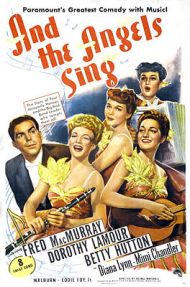It would be difficult to find a song with a more unusual history of success than the swing era classic, “And The Angels Sing.” Originally an instrumental with a Jewish klezmer-style segment, it would later have lyrics added and become a hit record for a famous big band, while at the same time turning into a signature song for both a vocalist and a trumpeter. It would also be the inspiration for a Hollywood musical that — oddly enough — did not include the song.
Leading his own band, trumpeter Ziggy Elman (b. Harry Aaron Finkelman) had originally performed an instrumental he’d written and named “Fralich in Swing,”which featured his distinctive klezmer-style solo half-way through. But by the time Ziggy joined Benny Goodman’s band in the late 1930s, Johnny Mercer had added words and the song had been renamed “And The Angels Sing.” After its performance in Goodman’s famous 1938 Carnegie Hall concert (maybe – but more later about that) it became a number-one hit and made a star of vocalist Martha Tilton, while also bringing a lot of attention to Ziggy Elman.
But even though the song was a huge hit, several strange things subsequently happened. The first occurred with the 1944 Fred MacMurray movie that took its title from the song. Even though the film contained eight musical numbers, “And The Angels Sing” was not one of them. Another movie — 1956’s The Benny Goodman Story — did include a shortened version of the song and showed Martha and Ziggy performing it at the Carnegie Hall concert, but it wasn’t his horn we heard. Although he was only in his forties at that time, Ziggy was past his prime and couldn’t handle the tricky solo, so it was dubbed by trumpeter Manny Klein. (Although Ziggy’s original was even trickier.)
The final oddity is that it’s very difficult to find the song on the many digital collections of the original 1938 Carnegie Hall event available now. Was it actually performed in the concert, or was the scene in the movie — which even shows audience members reading the song’s title in the program — a Hollywood fake? (Video below – movie picks up about half way through.)

Ziggy Elman & Orchestra – “Fralich in Swing”
What a wonderful memory. Thanks
LikeLike
Nice to hear from you again. Thanks for writing.
LikeLike
The history of “And the Angels Sing” goes back farther than the article indicates. Ziggy took as his starting point a traditional Klezmer (European Jewish Folk Music) tune known as Stille Bulgar, which means “Quiet Bulgarian Dance”. He slowed down the melody to serve as the tune for the swing part of the song. Then he played the trumpet solo with the original Klezmer feel.
Born Harry Finkelmen, he thought he could do better in the music business if he had a non-Jewish sounding name, so he picked Ziggy Elman.
LikeLike
But did he actually think that taking the name “Ziggy Elman” would fool anybody? Artie Shaw was more imaginative.
LikeLike
Thanks for the earlier history of the song, Tom. My original source didn’t mention that. I wonder if Ziggy played it down a little…after all, it was his claim to fame.
LikeLike
Ziggy Elman was my cousin!
LikeLike
That song was NOT performed at the Carnegie Hall Jazz Concert. “Bei Mir Bistu Shein” another song with a Ziggy Elman klezmer like solo was performed instead.
LikeLike
So you’re agreeing with the scenario I described in the last paragraph of the article? I think that too, but I’d like to know your source because it’s something I’ve always wondered about.
LikeLike
sorry, but your ‘final oddity’ is bupkis. i have a copy of the 2-disc, 331/3rpm, 12-inch, vinyl LP and i assure you it WAS performed at the 1938 concert.
LikeLike
Have you all heard Ella Fitzgerald swing this? It’s on her recently released live album ELLA AT ZARDI’S. Wow.
LikeLike
“At A High School Dance,” a 1961 rock song by Canadian singer-songwriter R. Dean Taylor, uses the identical melody as “And The Angels Sing,” presumably derived from the same klezmer source. It was a fair-sized hit in Canada and a minor one in the US. Taylor went on to later success as a Motown songwriter, and scored a major hit with “Indiana Wants Me.”
LikeLike